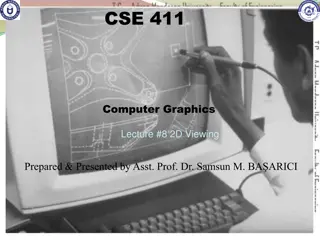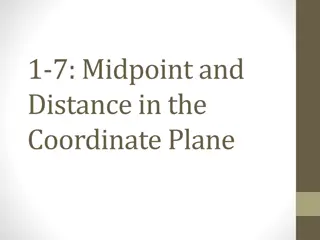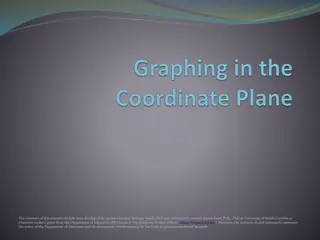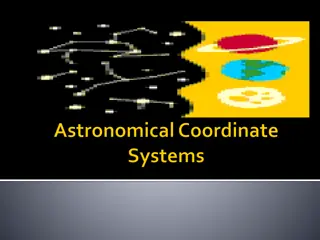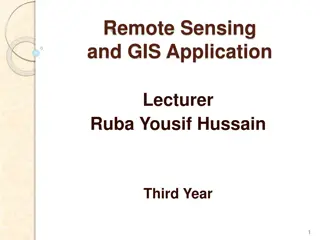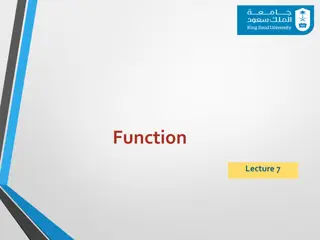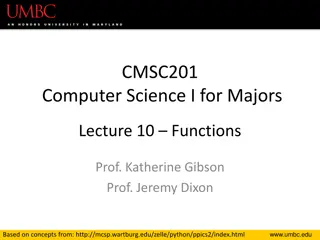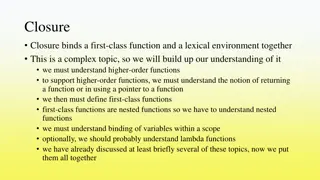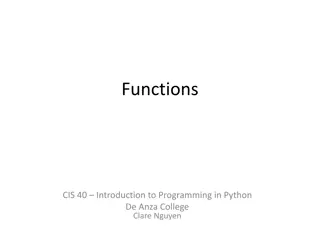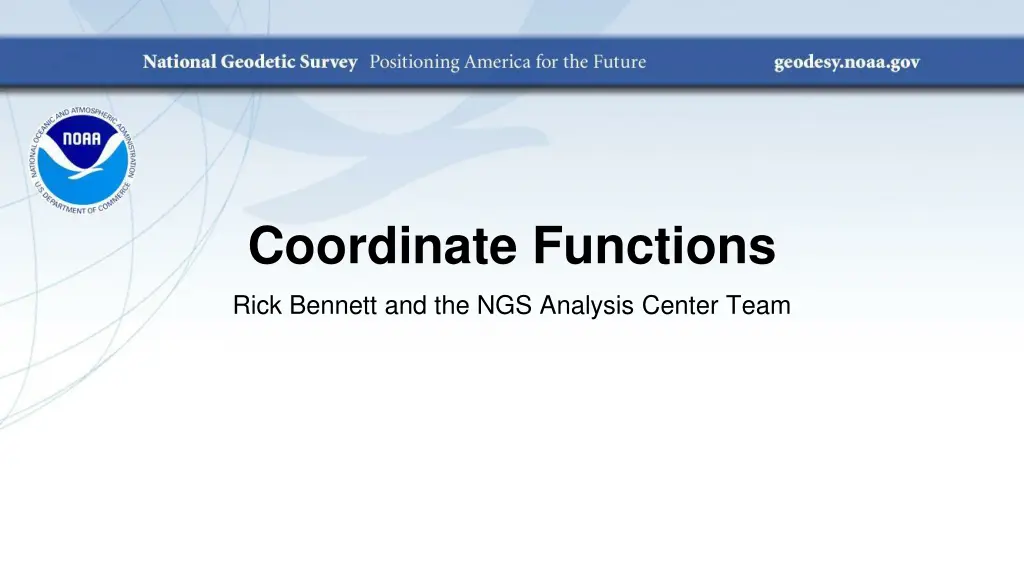
Understanding Coordinate Functions in Analysis
Explore the concept of coordinate functions and their significance in analysis, including linear and nonlinear terms, breakpoints, reference epochs, and real-world examples. Discover the necessity of coordinate functions for maintenance and binational coordination in data analysis processes.
Download Presentation

Please find below an Image/Link to download the presentation.
The content on the website is provided AS IS for your information and personal use only. It may not be sold, licensed, or shared on other websites without obtaining consent from the author. If you encounter any issues during the download, it is possible that the publisher has removed the file from their server.
You are allowed to download the files provided on this website for personal or commercial use, subject to the condition that they are used lawfully. All files are the property of their respective owners.
The content on the website is provided AS IS for your information and personal use only. It may not be sold, licensed, or shared on other websites without obtaining consent from the author.
E N D
Presentation Transcript
Coordinate Functions Rick Bennett and the NGS Analysis Center Team
Outline What are coordinate functions? Why do we need them? Maintenance and binational coordination
Describing station motion Credit: Machiel Bos
Coordinate functions Coordinate functions in general comprise both linear and nonlinear terms. However: x v1 1. Each breakpoint delimited segment of a CF has its own 2020.0 intercept reference epoch (not to be confused with the official REC). v2 v0 Credit: P. McFarland 2. These intercepts are determined exclusively from the linear portion of the CF for that segment. ?t1 ?t2 ?t ?t = time since reference epoch reference epoch (e.g., 2020.0)
Extreme real world example: IGS station AREQ SID X Y Z Vx Vy Vz Epoch Start Stop AREQ_G2A 1942826.94674 -5804070.23434 -1796893.71605 0.01188 0.00064 0.01371 2015.00000 1996.02600 1996.86343 AREQ_G3A 1942826.94316 -5804070.23985 -1796893.71319 0.01188 0.00064 0.01371 2015.00000 1996.86343 2001.47410 AREQ_G5A 1942826.46086 -5804070.27126 -1796894.02929 0.01188 0.00064 0.01371 2015.00000 2001.47410 2007.61935 AREQ_G6A 1942826.45544 -5804070.27362 -1796894.02739 0.01188 0.00064 0.01371 2015.00000 2007.61935 2014.24675 AREQ_G7A 1942826.45550 -5804070.27470 -1796894.02401 0.01188 0.00064 0.01371 2015.00000 2014.24675 2018.32894 AREQ_G8A 1942826.46202 -5804070.27804 -1796894.02152 0.01188 0.00064 0.01371 2015.00000 2018.32894 2022.89450
Extreme real world example: IGS station AREQ SID X Y Z Vx Vy Vz Epoch Start Stop AREQ_G2A 1942826.94674 -5804070.23434 -1796893.71605 0.01188 0.00064 0.01371 2015.00000 1996.02600 1996.86343 AREQ_G3A 1942826.94316 -5804070.23985 -1796893.71319 0.01188 0.00064 0.01371 2015.00000 1996.86343 2001.47410 AREQ_G5A 1942826.46086 -5804070.27126 -1796894.02929 0.01188 0.00064 0.01371 2015.00000 2001.47410 2007.61935 AREQ_G6A 1942826.45544 -5804070.27362 -1796894.02739 0.01188 0.00064 0.01371 2015.00000 2007.61935 2014.24675 AREQ_G7A 1942826.45550 -5804070.27470 -1796894.02401 0.01188 0.00064 0.01371 2015.00000 2014.24675 2018.32894 AREQ_G8A 1942826.46202 -5804070.27804 -1796894.02152 0.01188 0.00064 0.01371 2015.00000 2018.32894 2022.89450 Linear portions only Large diffs among intercepts @ the reference epoch
Extreme real world example: IGS station AREQ SID X Y Z Vx Vy Vz Epoch Start Stop AREQ_G2A 1942826.94674 -5804070.23434 -1796893.71605 0.01188 0.00064 0.01371 2015.00000 1996.02600 1996.86343 AREQ_G3A 1942826.94316 -5804070.23985 -1796893.71319 0.01188 0.00064 0.01371 2015.00000 1996.86343 2001.47410 AREQ_G5A 1942826.46086 -5804070.27126 -1796894.02929 0.01188 0.00064 0.01371 2015.00000 2001.47410 2007.61935 AREQ_G6A 1942826.45544 -5804070.27362 -1796894.02739 0.01188 0.00064 0.01371 2015.00000 2007.61935 2014.24675 AREQ_G7A 1942826.45550 -5804070.27470 -1796894.02401 0.01188 0.00064 0.01371 2015.00000 2014.24675 2018.32894 AREQ_G8A 1942826.46202 -5804070.27804 -1796894.02152 0.01188 0.00064 0.01371 2015.00000 2018.32894 2022.89450 Constant velocities for this case, but not in general Linear portions only Large diffs among intercepts @ the reference epoch Non-linear motions accounted for by additional model components (not shown in the table, but apparent in the graph).
Why do we need coordinate functions? future now 3 All CORS move over time 2 jump i.e. earthquake Coordinate functions describe the motion steady motion i.e. velocity 1 N past Station motion - map view E Drawings modified from P. McFarland
Why do we need coordinate functions? future now 3solution 3 is best predictor of future position Reference epoch 2 jump i.e. earthquake steady motion i.e. velocity 1 N past Station motion - map view E Drawings modified from P. McFarland
Why do we need coordinate functions? future now current point of interest jump i.e. earthquake steady motion i.e. velocity N past Station motion - map view E Drawings modified from P. McFarland
Why do we need coordinate functions? future now current point of interest Precise Obs Baseline Vector large jump i.e. earthquake positioning error steady motion i.e. velocity estimate N past Station motion - map view E Drawings modified from P. McFarland
Why do we need coordinate functions? more accurate coordinate of epoch future current point of interest erroneous coord of epoch Precise Obs Baseline Vector better point estimate jump i.e. earthquake steady motion i.e. velocity estimate N past Station motion - map view E Drawings modified from P. McFarland
Why do we need coordinate functions? even more accurate coordinate of epoch future current point of interest computed station coordinate periodic motion correction periodic motion jump i.e. earthquake Coordinate functions can include periodic motion models for better reference coordinate determination steady motion i.e. velocity N Station motion - map view E Drawings modified from P. McFarland
The MYCS3 Coordinate function model x(t) = xR+ vx(t - tR) + Axsin(2? ? t) +Bxcos(2? ? t) + Cxsin(4? ? t) +Dxcos(4? ? t) + gx(t) linear periodic (annual and semi-annual) NGS only for now Parameters Future enhancements FY26? FY27? X, Y, Z, Vx, Vy, Vz, 3x(A, B, C, D) Up to 18 (or 6) values per solution , i.e., model segment
Maintenance and Binational Coordination Updates may be required to account for earthquakes and as prediction errors accumulate. CGS and NGS will continue to collaborate/coordinate to ensure consistency among coordinate functions Future enhancements: CGS to include periodic components NGS to include post-seismic components





